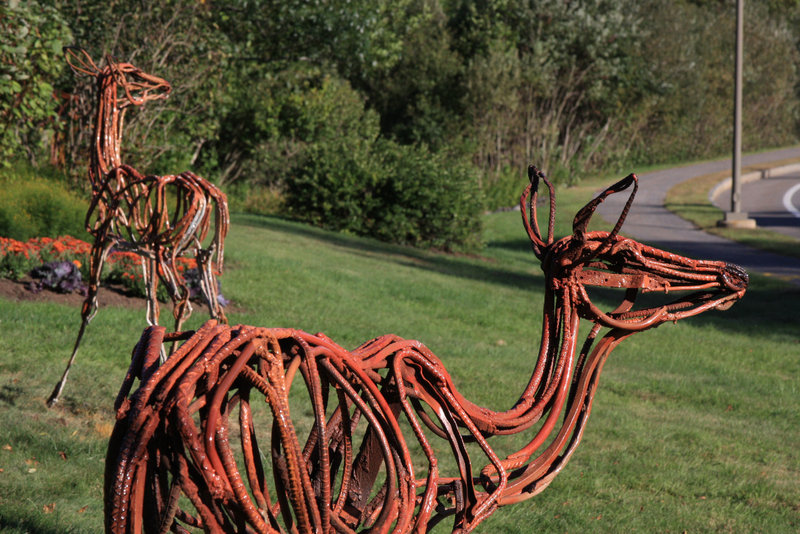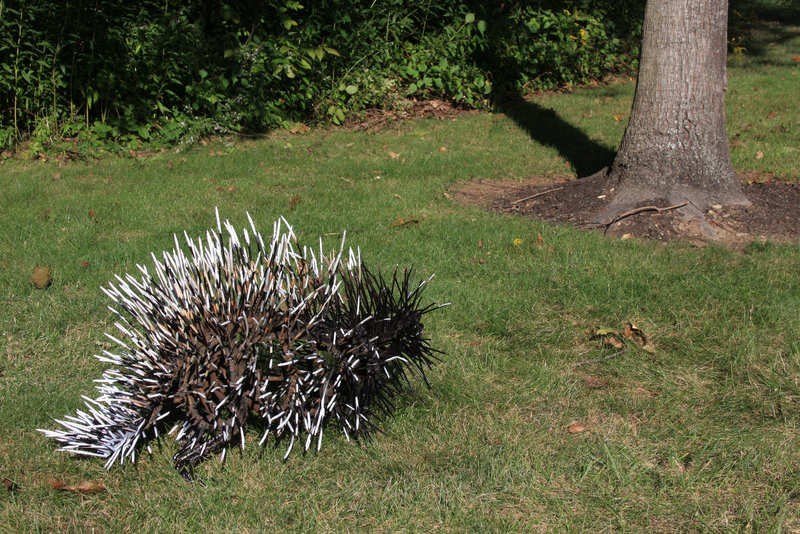On Friday, Wendy Klemperer’s seven-part sculpture “Glimpse” was unveiled on the access road to the Jetport.
“Glimpse” consists of eight metal sculptures in the form of six deer, one porcupine and a lone wolf. It is the most recent work added to Portland’s public art collection by the Public Art Committee.
What did it cost the city? Nothing. Not yet, at least.
In celebration of PWM’s recently completed expansion, “Glimpse” was purchased for Portland by William and Mary Hamill for $62,000 — including $5,000 for transportation and installation.
One of the myriad responsibilities of the PAC (which operates on a shoestring budget of about $50,000 per year) is deciding on what gifts to accept. After all, it can be very expensive to own works of outdoor art over time, because they have to be kept in decent repair for public safety as well as appearance.
Any museum professional will tell you that between administrative, storage, handling and restoration responsibilities, it’s expensive just to own a work of art. So when it comes to art, gift horses — and deer — must absolutely be looked in the mouth.
“Glimpse” is the first set of symbols many tourists will see as they leave the airport. The message is that Maine is about landscape, wildlife, art, environment and industry. It’s a beautiful sculptural installation that says, “Welcome to Maine.”
Set along a winding road surrounded by hillocks, trees and landscaped knolls, the metal sculptures catch your eye fleetingly, as would actual wildlife. It’s less obvious, but relevant, that the animals are made from rebar and scrap metal salvaged from industrial sites.
Considering tourism is our most significant industry, this is precisely the right set of messages. As well, because the welded metal is more like drawing than solid forms, it plays up the artistic intelligence of the sculptures with a light touch. Their immateriality plays on how memory, history and even passing glimpses combine to create a sense of place.
While probably most art professionals draw sharp distinctions between monuments, statuary and other forms of public art, I don’t. For me, they are all about a sense of place, cultural memory and respect. Public art sends the message that we care about our city and we think it’s a great place to be.
This not only affects our quality of life but has a major economic impact as well: If Portland didn’t invest in its brick sidewalks, cobblestone streets, architecture, landscaping, holiday decorations and public art, it certainly wouldn’t be the tourist draw it is now.
While Klemperer’s deer aren’t wholly independent of Deborah Butterfield’s famous metal horses, they are less iconic and more naturalistic in their poses. They tend to be larger than life: One that seems to be prancing toward the road (maybe not the best placement) is 7 feet tall — hardly representative of what Maine hunters are bringing home this weekend.
Because wolves were largely extirpated from Maine more than a century ago, Klemperer’s huge, howling wolf is the most ghostly of the figures. It is also the most fleetingly sited — at the top of a hill and not on an obvious sight line.
The life-sized porcupine is the most mundane, yet with its quills of long-shank nails, plodding gait and punctuating placement near the road, it’s the wittiest.
All in all, I think “Glimpse” is some good art that serves as a great reminder that artists, donors, dealers and volunteers are working together to make Portland more appealing and welcoming to the people who come to Maine’s leading city.
Freelance writer Daniel Kany is an art historian who lives in Cumberland. He can be contacted at: dankany@gmail.com
Send questions/comments to the editors.




Success. Please wait for the page to reload. If the page does not reload within 5 seconds, please refresh the page.
Enter your email and password to access comments.
Hi, to comment on stories you must . This profile is in addition to your subscription and website login.
Already have a commenting profile? .
Invalid username/password.
Please check your email to confirm and complete your registration.
Only subscribers are eligible to post comments. Please subscribe or login first for digital access. Here’s why.
Use the form below to reset your password. When you've submitted your account email, we will send an email with a reset code.